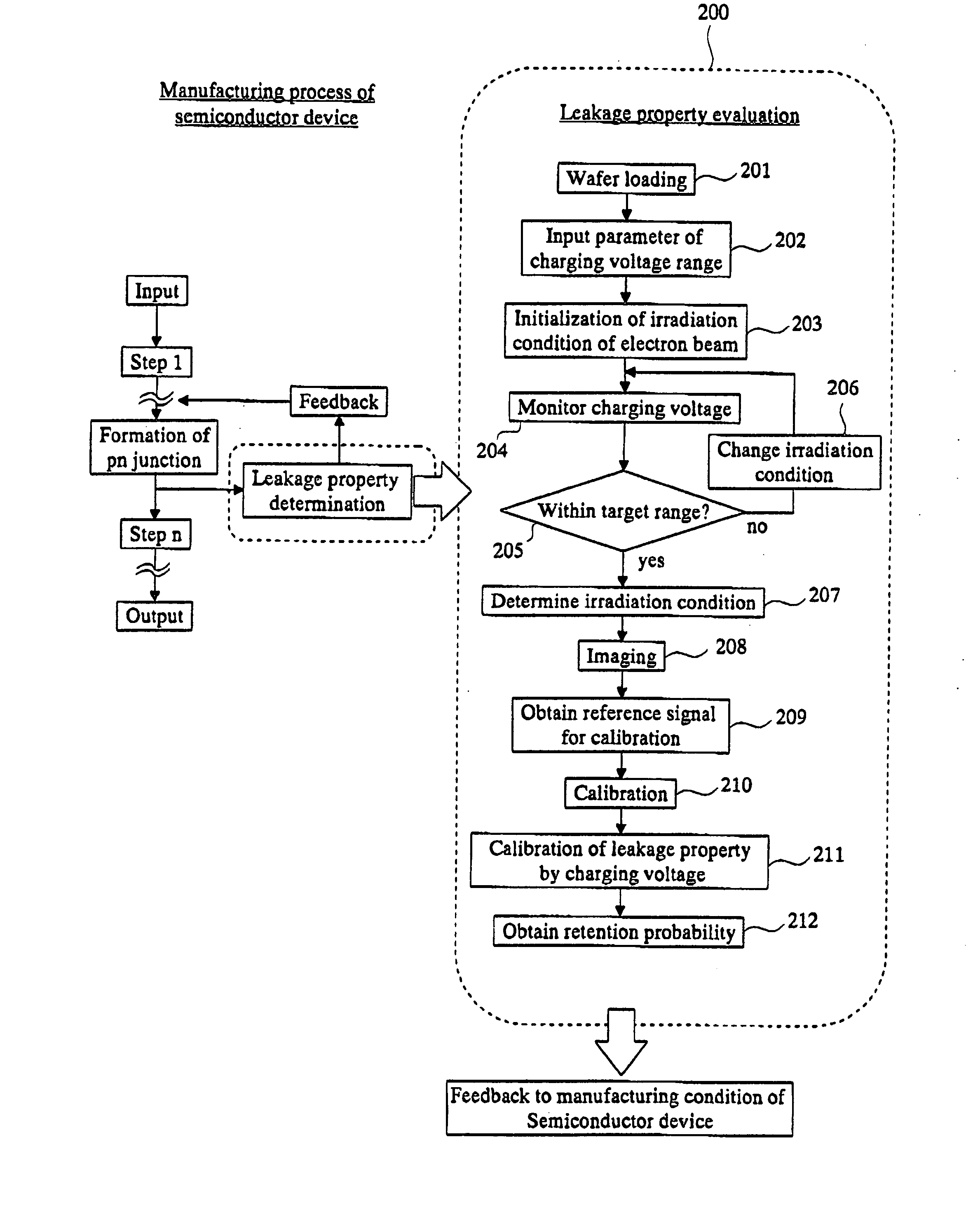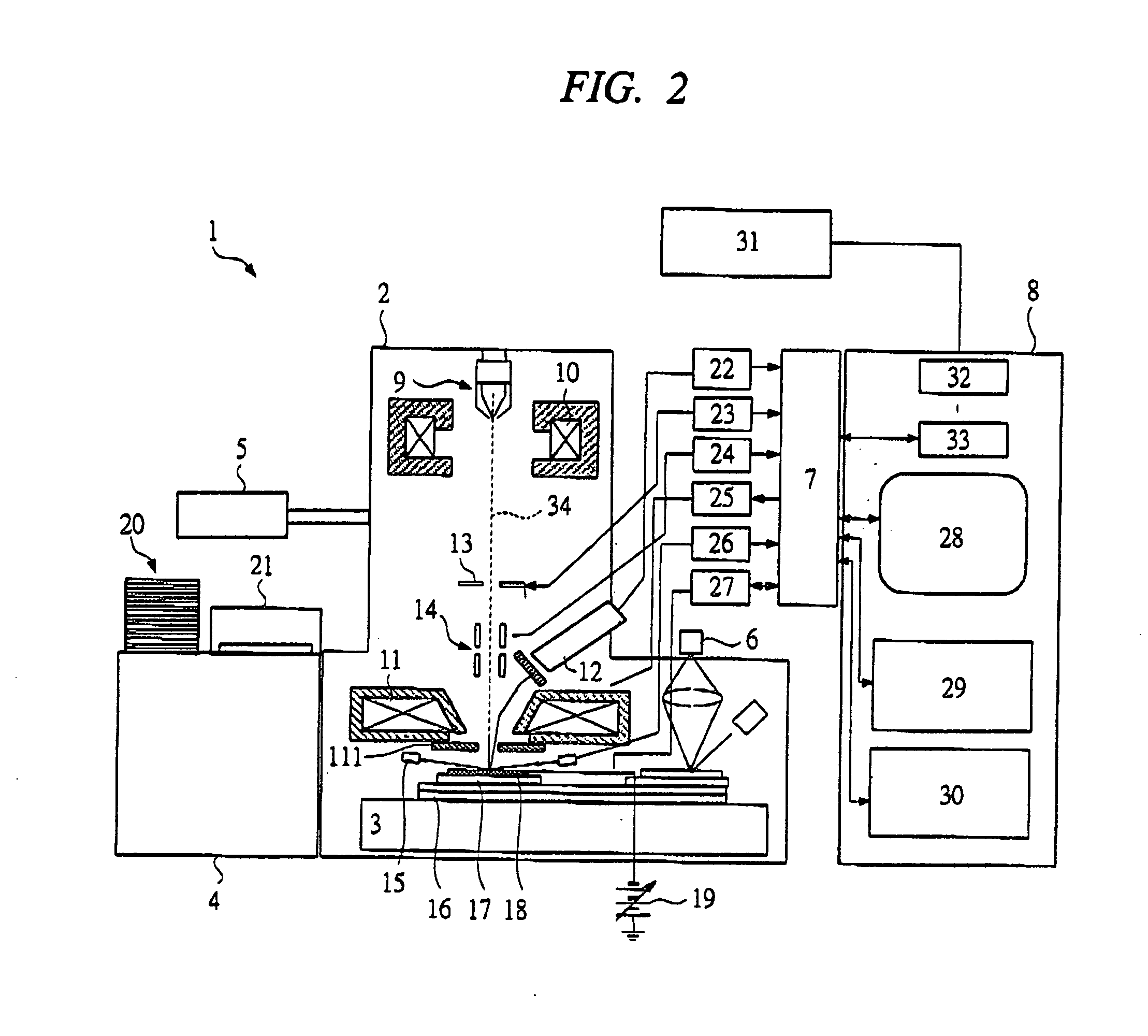Evaluation method and manufacturing method of semiconductor device
a technology for semiconductor devices and manufacturing methods, applied in semiconductor/solid-state device testing/measurement, instruments, basic electric elements, etc., can solve the problems of inability to detect leakage failure, inability to accurately measure, and difficulty in detecting leakage failures. , to achieve the effect of improving the reliability of semiconductor devices, accurate measurement, and reducing the percent of defectives
- Summary
- Abstract
- Description
- Claims
- Application Information
AI Technical Summary
Benefits of technology
Problems solved by technology
Method used
Image
Examples
first embodiment
[0042] In this embodiment, the evaluation method of leakage property and the evaluation system are provided, in which the reverse bias current property (leakage property) is evaluated while monitoring the charging state on the surface of the plug connected to the device in the wafer on which the semiconductor devices in the course of the manufacturing process are fabricated.
[0043] First, the flow of the evaluation method of the leakage property of a semiconductor device according to this embodiment will be described in brief. FIG. 1 shows the flow of the method. After inputting a wafer into the semiconductor manufacturing apparatus, the process is started from the step 1. When the step of forming the pn junction is finished, the wafer on which the plugs are exposed is taken out, and the main evaluation 200 is started. First, as a step 1 (201), the wafer on which the pn junction has been formed is loaded (carried) in the evaluation system. Then, as a step 2 (202), a desired charging...
second embodiment
[0093] Next, as the second embodiment, the manufacturing method of a semiconductor device will be described, in which the evaluation method shown in the first embodiment is applied to the manufacturing process of a semiconductor device to give the feedback to the semiconductor manufacturing conditions in an early stage. By applying the evaluation method in the course of the manufacturing process, it becomes possible to know the leakage current distribution of a DRAM, the leakage current of the normal bits which form the main profile and that of the abnormal bits which form the tail profile, and the number and ratio of the abnormal bits in an early stage. Consequently, the process conditions capable of reducing the leakage current and the number and ratio of the abnormal bits can be determined in the step of forming a junction in a shorter time than that of the conventional technology.
[0094] In the development of the DRAM, the evaluation of the reverse bias current in the pn junctio...
third embodiment
[0098] The case where the present invention is applied to the wafer in the manufacturing line processed through the steps shown in FIG. 17 to FIG. 20 in the manufacturing process of a stack-type DRAM to give the feedback to the adjustment conditions of the processing apparatus will be described below.
[0099] As shown in FIG. 17, a p type substrate 51 with a specific resistance of about 10 Ωcm is prepared, and shallow trenches 52 are formed in the main surface of the substrate 51. Thereafter, a silicon oxide film 53 is formed by the thermal oxidation of the substrate 51. Then, a silicon oxide film is deposited and is polished by the CMP (Chemical Mechanical Polishing) to leave the silicon oxide film only in the shallow trenches 52, thereby forming the isolation areas 54. Next, a n type impurity, for example, phosphorus (P) is ion-implanted into the area (A area: memory array) of the substrate 51 on which the memory cell is to be formed, thereby forming the deep n type well 55. Also, ...
PUM
 Login to View More
Login to View More Abstract
Description
Claims
Application Information
 Login to View More
Login to View More - R&D
- Intellectual Property
- Life Sciences
- Materials
- Tech Scout
- Unparalleled Data Quality
- Higher Quality Content
- 60% Fewer Hallucinations
Browse by: Latest US Patents, China's latest patents, Technical Efficacy Thesaurus, Application Domain, Technology Topic, Popular Technical Reports.
© 2025 PatSnap. All rights reserved.Legal|Privacy policy|Modern Slavery Act Transparency Statement|Sitemap|About US| Contact US: help@patsnap.com



